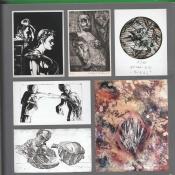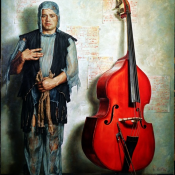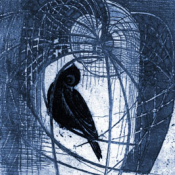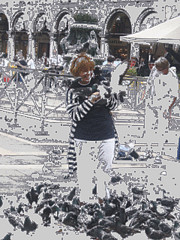Creation Category:
The Romanian sculptor, Constantin Brancusi was born on February 19, 1876, in Hobitza, a village in Romania's Carpathian Mountains, an area known for its rich tradition of folk crafts, particularly ornate wood carving. His parents, Nicolae and Maria Brâncuși, were poor peasants who earned a meager living through back-breaking labor, and from the age of seven he herded the family's flock of sheep. He showed remarkable talent for carving objects out of wood. At the age of nine, Brâncuși left the village to work at menial jobs in the nearest large town. At 13 he went to Craiova where he worked at a grocery store for several years. When he was 18, impressed by Brâncuși's talent for carving, his employer financed his education at the Craiova School of Crafts (Școala de Meserii). There he indulged his love for woodworking, taught himself to read and write, and graduated with honors in 1898.
He studied art at the Scoala Natzionala de Arte Frumoase (National School of Fine Arts) in Bucharest from 1898 to 1901. Eager to continue his education in Paris , Brancusi arrived there in 1904 and enrolled in the Ecole des Beaux-Arts in 1905. The following year, his sculpture was shown at the Salon d’Automne, where he met Auguste Rodin. Barncusi’s old Dacian art and culture influences met Rodin’s. After leaving Rodin's workshop, Brâncusi began to develop the revolutionary style for which he is known. Brancusi wished to make the work much simpler and began an innovative search for the pure form, by reducing his creation to a few basic elements.
Paradoxically, now, Brancusi's sculptures are rightly considered to be the work of a modern master, when in fact he is a follower of ancient Dacian traditions.The Romanian sculptor, Constantin Brancusi, was a central figure of the modern movement and a pioneer of abstractionism, as some people are considering him. But let’s see what was Brancusi’s opinion about being considered a “pioneer of abstractionism“: “The people who call my work 'abstract' are imbeciles; what they call 'abstract' is in fact the purest realism, the reality which is not represented by the external form but by the idea behind it, the essence of the work.” “What is real is not the external form, but the essence of things... it is impossible for anyone to express anything essentially real by imitating its exterior surface.”His sculptures are noted for their visual elegance and sensitive use of materials, combining the ancient Dacian techniques in stone, marble and wood carving, with the sophistication of the Parisian avant-garde practices. In his daily life, his interests ran from science to music, being a talented singer and violinist with eclectic musical tastes. He was known for his skill in preparing traditional Romanian dishes. He was a talented handy man, being able to build his own phonograph, most of his furniture, utensils and doorways. Brancusi traveled extensively in the 1930's, visiting and as well as European countries.The artist created his first major work, The Kiss, in 1908, when he was 32 years old. From then on, his sculpture became increasingly abstract, moving from the head of the Sleeping Muse to the virtually featureless Beginning of the World and from the formal figure of the legendary Magic Bird, to numerous versions of the heavenly Bird in Space. Brancusi's sculpture gained international notoriety at the 1913 Armory Show in New York , a city that he visited four times and where his work frequently was exhibited. In October 1926, Constantin Brancusi arrived from, in New York’s harbor on the steamship Paris, escorted by the artist Marcel Duchamp. He brought with him the sculptures which were supposed to be exhibited in the city at the avant-garde Brummer Gallery.The United States Customs officials opened the crates and uncovered 20 mysterious disks, eggs, and flame-like forms of carved wood, polished metal, or smooth marble. They refused to exempt them from customs duties, as works of art. They imposed the standard tariff for manufactured objects of metal: 40 percent of the sale price, or $240 (about $2,400 in today’s dollars). In general, was their opinion that Brancusi put too much imagination in his work.
The next month, the case of Brancusi vs. United States Abstract Art went to trial. Six influential figures testified for Brancusi: Steichen, who was an established photographer; the sculptor Jacob Epstein; Forbes Watson, the editor of the review The Arts; Frank Crowninshield, the editor of Vanity Fair; William Henry Fox, the director of the Brooklyn Museum of Art; and the art critic Henry McBride. The witnesses for the government were the sculptors Robert Aitken and Thomas Jones. During the hearing, Judges Young and Waite placed great emphasis on the Bird’s title. The Tariff Act didn’t require that sculptures be realistic, but under a 1916 Customs Courtdecision called vs. Olivotti, sculptures qualified as art works only if they were “chiseled” or “carved”, “imitations of natural objects”, chiefly the human form representing such objects “in their true proportions.”
Thomas Jones, a professor at Columbia who testified for the Customs office, said that the Bird was “too abstract and a misuse of the form of sculpture.” Robert Aitken, the government’s other witness, said that art should “arouse an unusual emotional reaction” and “stir the esthetics, the sense of beauty.” Every work by Brancusi was unique and made of a different material, with different proportions and different harmonies. Brancusi had carved different types of Birds out of white, yellow, and black marble and bronze, giving them different compositions, each time coaxing the stone or the metal to reveal something new about the form. As Brancusi explained, all of those pieces were part of the same search: “All my life I’ve been looking for one thing, the essence of flight.” The court favored Brancusi. In its decision of November 1928, drafted by Judge Waite, the court upheld: “The object now under consideration … is beautiful and symmetrical in outline, and while some difficulty might be encountered in associating it with a bird, it is nevertheless pleasing to look at and it is the original production of a professional sculptor and ….. we sustain the protest and find that it is entitled to free entry.” Judge Waite’s decision was seen as a victory not only for Brancusi, but also for the avant-garde art, because it dismissed the Olivotti requirement and recognized the importance of a new school that “portrayed abstract ideas rather than… imitating natural objects.” In the 1930's, Brancusi worked on two ambitious public sculpture projects. One, was an unrealized temple in for the Maharajah of Indore. The other one, was the setting up at Tirgu Jiu, , of the monument commemorating the courage and sacrifice of the Romanian civilians who, in 1916 fought off the German invasion. This monument is comprised of the Gate of the Kiss, the Table of Silence and a 100-foot tall cast iron version of the Endless Column, which he finished in 1938 and inaugurated on 27 October 1938. These sculptures, based on the symbolism of the Dacian beliefs, were made as a tribute to the young Romanians who died in World War I fighting . As a matter of fact, the Endless Column is a stylization of the funerary pillars used in Old Dacia, more then 2000 years ago when our ancestors used to burn the body of a dead person, in this way releasing their soul from the imprisonment (confines) of the body. The soul was taken by the Magic Bird to the supreme god, Zalmoxis. Brancusi did not have enough money to finish the Endless Column, so the Magic Bird is missing from the top of the column. If you visit the heart of Transylvania, I suggest that you go near Deva, at Orastie, a pretty large town, were you will find the Dacian History Museum were 8 Dacian endless columns are ready to prove where Brancusi’s inspiration came from. The Endless Column is 29.33 meters (96.23 ft) high and is composed of 17 rhombus-shaped modules, made out of cast iron. Like 2000 years ago, it still represents the same symbol, the immortality of the fallen braves. The Târgu Jiu ensemble marks the apex of his artistic career. In his remaining 19 years he created less than 15 pieces, mostly reworking earlier themes, and while his fame grew he withdrew. It is remarkable that Brancusi was born in , which was the cradle of the European civilization. Around 9,000-10,000 years ago, some tribes of hunters and gatherers from the west coast of the what is called today the Black Sea, at that time a vast freshwater lake, began to use new techniques, and started to produce animal and human figures, pottery, copper and other metal artifacts. They also built palaces, temples and ships and created weaving techniques. The sensational flood that occurred 8,600 years ago in the Black Sea was a catastrophic event, which changed their history and the history of humanity. The so called Black Sea people fled, dispersing their language, genes, memory and their writing, not only West and North-West of Europe, but also to Asia and South-East into the Levant, and Mesopotamia . The archaeologists have found vestiges of four ancient civilizations: 1. One group of farmers called “Linear-band-Keramic”,(LBK), a name derived from their distinctive style of pottery, appeared in Europe within a century an a half after the flood, in mid sixth millennium B.C., rapidly occupying an arc from the Dniester River across northern Europe as far as the Paris basin, displacing the indigenous hunter-gatherers. The LBK pottery was decorated almost exclusively with incised patterns grooves and bands of dotted lines forming spirals, waves, concentric rectangles, and other geometric designs, almost all without applied color. 2. Simultaneously with the appearance of the LBK, the Vinca civilization emerged abruptly on the plains of what is known today as , , , , settling on the river terraces. The art and pottery at Vinca were exceptional, in total contrast with the prior civilization. A mother on a throne holding a child in her arms was found in a small village called Rast, in western which belonged to the Vinca culture. Both figures are covered with strange geometrical and abstract motifs that suggest, according to Marija Gimbutas, writing. This is astonishing, because this “Madonna” is over 7,000 years old. Found primarily in graves, many such statuettes may have represented fertility figures. In the early 20th century, many European artists, including Constantin Brancusi, admired Vinca sculpture for its abstracted stylization. Today we can see at the Museum of Fine Arts , in Houston, Texas , Brancusi’s Female Idol, as a result of inspiration from the old pre Dacian culture. 3. The Danilo-Havar (DH) people settled along the Adriatic coast of Dalmatia in several of the fertile valleys that cut through the mountains to the sea, strategically located at the seaward end of the Neretva River valley. DH pottery was sophisticated decorated with rich patterns of chevrons, spirals, running waves, nested S’s, and other geometric figures, sometimes painted in black and red. 4. People called Hamangians also seemed to emerge out of nowhere to settle in the region of south-east costal . Two fascinating and quite modern-looking sculptures from early in the fifth millennium B.C. were found together in a grave (Hamangia-Romania), the “Thinker” and his wife. Although Rodin is considered to be the progenitor of modern sculpture, his Thinker reminds us of Hammangia’s Thinker, found on the territory of Romania , which is, however, 8,600 years older. Also in , ( Sibiu Museum ) a 7500-year-old phallus, carries an inscription in the lost proto-European script that has never been deciphered. In 1920, Brancusi increased his growing fame with the entry of "Princess X" in the Salon des Indépendants, in Paris . The phallic shape of the piece scandalized the Salon, and despite Brâncusi's explanation that it was an anonymous portrait, it was removed from the exhibition. Brancusi died on March 16, 1957 at the age of 81 leaving 1200 photographs and 215 sculptures. He was burried in the Cimetière du Montparnasse in Paris . Also located in that cemetery are statues carved by Brâncusi for several fellow artists who died earlier; the best-known of these being "Le Baiser" ("The Kiss"). Brâncusi was posthumously inducted as a member of the Romanian Academy in 1990. The artist was not only a real decedent of the Dacian people, but he used his genius to bring back to live the old art, traditions and symbolism of our ancient culture.
source: www.dacia.org |










